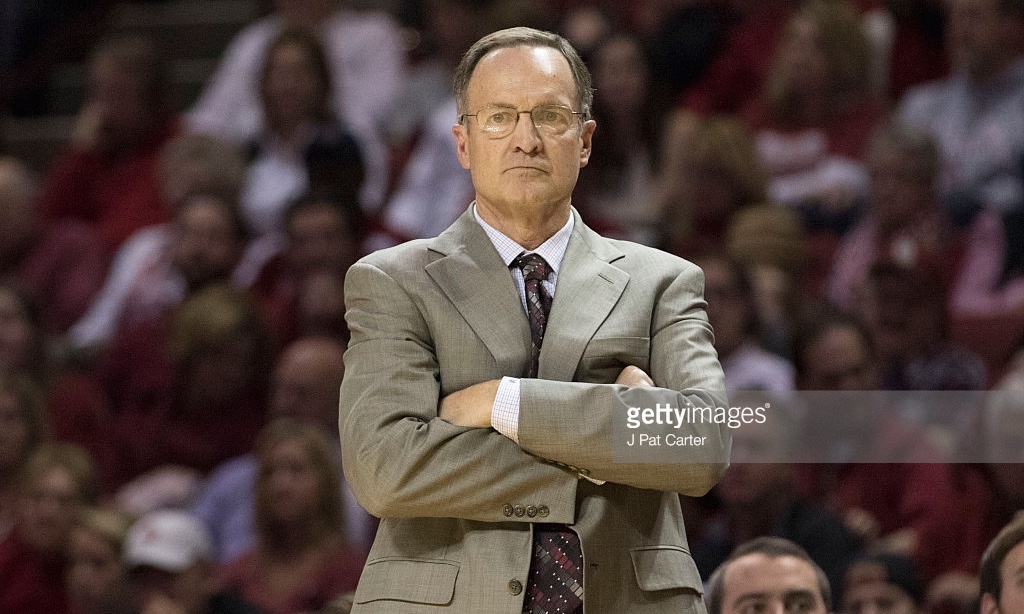Zero. That’s the number of current Oklahoma players who were alive the last time the Sooners were the number one ranked college basketball team in the country. It had been 26 long years since Skeeter Henry led the 1990 Sooners to the top of the AP poll. Coming into Saturday’s game against West Virginia, Lon Kruger’s squad knew they were on the brink of history. Khadeem Lattin’s go ahead tip-in off of a Jordan Woodard layup with 2.8 seconds left sunk the Mountaineers and sealed the win that finally put the Sooners on top of the college basketball world again. On Monday morning, all 65 AP voters had Oklahoma at the top of their weekly rankings. That means that this current Sooner team has now accomplished a feat that neither the 2002 Final Four team nor the 2009 Blake Griffin-led team ever did.
The college basketball world was put on notice earlier this month after the Sooners triple-overtime thriller against the Jayhawks in Lawrence. The Jayhawks ultimately squeaked out a 3-point victory, but the game had a very Rocky-like feeling as Oklahoma sent Bill Self and company a clear message that their 12th straight Big 12 title would not come without a fight. Several Sooners made strong statements with their January 4th performances. Junior guard Jordan Woodard dropped 27 points, and forwards Khadeem Lattin and Ryan Spangler both notched double-doubles. The most impressive performance of the night was without question reigning conference player of the year Buddy Hield’s 46-point performance. Hield’s tremendous night in Lawrence established him as the frontrunner for the Wooden Award. He also catapulted his team to national prominence seemingly overnight. However, the story of the team that is now number one in the country began long before January 4th.
Norman, Oklahoma March 2011: Coach Jeff Capel is finishing cleaning out his belongings from his office after an abysmal two-year run during which his team went 17-36. Saying that the Sooners had become a doormat for rest of the Big 12 after Blake Griffin’s departure for the NBA is putting it lightly. They had finished 10th in the conference (back when the Big 12 actually had 12 teams) for the second consecutive season and weren’t even close to being good enough to qualify for the NIT. It appeared that Oklahoma athletics would return to what they had been for the better part of the last twenty years: a football powerhouse whose basketball program was merely an afterthought in the athletic department. Enter Lon Kruger.
A nomadic coach for more than 3 decades, Kruger had experienced success at almost every stop along the way. As a head coach, he had taken four schools (Kansas State, Florida, Illinois, and UNLV) to the NCAA Tournament, and even got Florida all the way to the Final Four in 1994. He seemed to be the perfect fit to take over a program trying to get back on track after a two-year tailspin.
Kruger’s April hiring made it impossible for him to piece together any kind of recruiting class of his own, so he was forced to use what little scraps Capel left him. Combine the lack of talent with the uphill battle of trying to run a basketball program at a school that puts an unbalanced emphasis towards football, and Kruger’s task seemed improbable at best.
The Sooners’ first season under Kruger was not much of an improvement from the previous year. His team went a mediocre 15-16 and finished tied for 8th in the Big 12. They had bad losses against Texas Tech by 18 and Kansas by 22. Despite their lack of success on the court, Kruger managed to land one big name recruit in his first year. A stick-thin shooting guard from Wichita, Kansas named Buddy Hield shocked a few people by choosing Oklahoma over Kansas. In addition to Hield, the Sooners also made a couple of moves that seemed insignificant at the time. Forward Ryan Spangler transferred to Oklahoma after spending his freshman year buried at the end of Gonzaga’s bench. An afterthought in the 2012 recruiting class was two-star guard Isaiah Cousins whose potential looked to be nothing more than a role player playing limited minutes. This recruiting class didn’t even rank among the top 40 in the nation. Kruger knew he wasn’t going to get the 5-star, one and done players that Duke and Kentucky had built their programs around, and that didn’t seem to bother him. He understood that the key to building a championship basketball team is the same as preparing a good steak: start with quality raw meat and let it marinate.
The Sooners 2012-2013 and 2013-2014 campaigns were both sizable steps towards their goal of regaining national relevancy. They won over 20 games in Kruger’s second and third seasons, and skyrocketed all the way up to a second place finish in the Big 12 in 2014. Kruger made history when he became the first coach in history to take five different schools to the NCAA Tournament. Although the Sooners were bounced in the first round two years in a row, their stock was on the rise and they showed no signs of slowing down.
By the time the 2014-2015 season rolled around, Hield, Woodard and Cousins had developed into one of the best backcourts in the Big 12, and Spangler was putting up double-doubles on almost a nightly basis. The Sooners tore through the regular season, winning seven games over top 25 opponents. They finished just one game behind Kansas for the Big 12 Championship and were one wide-open layup away from making it to the finals of the conference tournament. Kruger cleared another hurdle last season with his first NCAA Tournament wins as the head coach of the Sooners. The team reached the Sweet Sixteen with victories over Albany and Dayton before suffering a heartbreaking four-point loss to Michigan State, who later made it all the way to the Final Four.
Individually Buddy Hield averaged 17.4 points per game on his way to being named Big 12 player of the year last season. He was now faced with the gut-wrenching decision that so many elite college athletes have to make: stay in school one more year and make one last run at the Final Four, or declare for the NBA Draft (where he likely would’ve been a lottery pick) and cash in years of hard work for a multi-million dollar contract.
“I’m on a great team and we have a lot of unfinished business. I just can’t wait to see what’s in store for next year. I want to go to the Final Four. That’s always been a dream for me.” he said after last season.
Sooner nation cheered (the rest of the Big 12 didn’t) as Hield announced his plan to return to Norman for his senior season. The bond that he had forged with his teammates, particularly Cousins and Spangler, was worth more to Hield than the millions of dollars he would miss out on. He also risked the possibility of a catastrophic injury that could end his NBA dreams before they even began. He didn’t care. He was determined to finish the task they’d began three years earlier.
The Sooners came out guns blazing this season after being ranked eighth in the preseason poll. They started out 12-0 before that 3OT loss in Lawrence, but rebounded to edge out back-to-back two-point victories over Oklahoma State and West Virginia. While their loss Monday night in Ames likely means that their time at number one will be short-lived, their potential remains anything but limited.
The Sooners have all of the pieces necessary to compete for a national championship. They have a legitimate star player in Hield, who is averaging over 26 points per game this season, and they have a solid supporting cast of Spangler, Cousins, and Woodard who can all step up and carry the load on any given night. They shoot the three better than anyone in the nation at 46% and rank among the top ten in total points per game. In a season where no team in college basketball has looked dominant, the Sooners have as good a shot as anyone to make a deep run in March.




